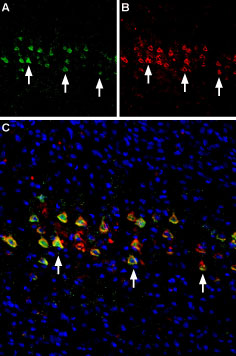Overview
- Peptide (C)EDFDNMKKVRLP, corresponding to amino acid residues 96-107 of rat nAChRβ2 (Accession P12390). Extracellular, N-terminus.

 Expression of nAChR β2 in rat cerebellumImmunohistochemical staining of rat cerebellum using Anti-Nicotinic Acetylcholine Receptor β2 (CHRNB2) (extracellular)-ATTO Fluor-594 Antibody (#ANC-012-AR). A. Staining shows labeling of cells in the granule layer (GL) and of some Purkinje cells (arrows). B. DAPI is used as the counterstain (blue).
Expression of nAChR β2 in rat cerebellumImmunohistochemical staining of rat cerebellum using Anti-Nicotinic Acetylcholine Receptor β2 (CHRNB2) (extracellular)-ATTO Fluor-594 Antibody (#ANC-012-AR). A. Staining shows labeling of cells in the granule layer (GL) and of some Purkinje cells (arrows). B. DAPI is used as the counterstain (blue).
 Expression of nAChR β2 in rat PC12 cellsCell surface detection of nAChR β2 in live intact rat pheochromocytoma PC12 cells. A. Cells were stained with Anti-Nicotinic Acetylcholine Receptor β2 (CHRNB2) (extracellular)-ATTO Fluor-594 Antibody (#ANC-012-AR), (1:50), (red). B. Live view of the cells. C. Merge of the two images.
Expression of nAChR β2 in rat PC12 cellsCell surface detection of nAChR β2 in live intact rat pheochromocytoma PC12 cells. A. Cells were stained with Anti-Nicotinic Acetylcholine Receptor β2 (CHRNB2) (extracellular)-ATTO Fluor-594 Antibody (#ANC-012-AR), (1:50), (red). B. Live view of the cells. C. Merge of the two images.
- Albuquerque, E.X. et al. (2009) Physiol. Rev. 89, 73.
- Karlin, A. et al. (1986) Ann. NY. Acad. Sci. 463, 53.
- Kalamida, D. et al. (2007) FEBS J. 274, 3799.
- Blonde, A. et al. (2000) Psychopharmacology (Berl.) 149, 293.
- Wilens, T.E. et al. (1999) Am. J. Psychiatry 156, 1931.
- Tanner, C.M. et al. (2002) Neurology 58, 581.
- Schneider, J.S. et al. (1998) Ann. Neurol. 43, 311.
Acetylcholine, released by cholinergic neurons, activates two groups of acetylcholine receptors (AChRs); muscarinic AChRs (mAChRs) which belong to the superfamily of G-protein coupled receptors (GPCRs) and nicotinic AChRs (nAChRs) which belong to the ligand-gated ion channel superfamily.
nAChRs also respond to nicotine, hence their name1. To date, 17 different but related subunits of nAChRs have been identified and cloned. They consist of α subunits (α1-10), which is responsible for the binding of ligands. In fact, this subunit includes a Cys-loop in the first extracellular domain that is required for agonist binding2. The other subunits responsible for making up the active receptor are the β (β1-4), γ, δ and ε subunits3.
Structurally, all subunits have the following: a conserved large extracellular N-terminal domain, 3 conserved transmembrane domains, a variable cytoplasmic loop and a fourth transmembrane domain with a short extracellular C-terminal domain.
An active nAChR is generally a heteropentamer of these various subunits organized around a central pore1.
While most β subunits are neuronal, the β1 subunit forms functional receptors along with other subunits in the muscle3. The diversity of these receptors and their functional organization gives rise to unique properties and functions. The α4β2 receptor composition makes up a high affinity nicotinic receptor. In fact, its upregulation (mainly expressed by the increase of functional receptors at the membrane and not expression per se) is responsible for the increased appearance of binding sites following nicotine administration1,3.
Animal studies have shown that nAChR-related mechanisms are involved in attention function4. Indeed α4β2 nAChR seems to also be involved in attention-deficit hyperactivity disorder (ADHD), a disease distinguished by a lack of attention, distractibility and hyperactivity3. The α4β2 and α7 nAChRs appear to be critical in rats for attention and working memory. Also, a α4β2 specific agonist was shown to reduce impulsivity, hyperactivity and attention deficits in adults with ADHD5. This same receptor subtype may also be involved in Parkinson’s disease (PD) as smoking and α4β2 nAChR agonists show beneficial effects in PD6,7.
Application key:
Species reactivity key:
Anti-Nicotinic Acetylcholine Receptor β2 (CHRNB2) (extracellular) Antibody (#ANC-012) is a highly specific antibody directed against an epitope the rat protein. The antibody can be used in western blot, immunohistochemistry, and immunocytochemistry applications. It has been designed to recognize nAChRβ2 from mouse, rat, and human samples.
Anti-Nicotinic Acetylcholine Receptor β2 (CHRNB2) (extracellular)-ATTO Fluor-594 Antibody (#ANC-012-AR) is directly labeled with an ATTO-594 fluorescent dye. ATTO dyes are characterized by strong absorption (high extinction coefficient), high fluorescence quantum yield, and high photo-stability. The ATTO-594 fluorescent label belongs to the class of Rhodamine dyes and can be used with fluorescent equipment typically optimized to detect Texas Red and Alexa-594. Anti-Nicotinic Acetylcholine Receptor β2 (CHRNB2) (extracellular)-ATTO Fluor-594 Antibody is especially suited for experiments requiring simultaneous labeling of different markers.
 Multiplex staining of nAChR α4 and nAChR β2 in mouse brainImmunohistochemical staining of perfusion-fixed frozen mouse parietal cortex sections using Anti-Nicotinic Acetylcholine Receptor α4 (CHRNA4) (extracellular) Antibody (#ANC-004), (1:300) and Anti-Nicotinic Acetylcholine Receptor β2 (CHRNB2) (extracellular)-ATTO Fluor-594 Antibody (#ANC-012-AR), (1:60). A. nAChR α4 staining (green). B. Same section stained for nAChR β2 (red). C. Merge of the two images reveals several cells expressing both receptors (arrows). Nuclei are stained with DAPI (blue).
Multiplex staining of nAChR α4 and nAChR β2 in mouse brainImmunohistochemical staining of perfusion-fixed frozen mouse parietal cortex sections using Anti-Nicotinic Acetylcholine Receptor α4 (CHRNA4) (extracellular) Antibody (#ANC-004), (1:300) and Anti-Nicotinic Acetylcholine Receptor β2 (CHRNB2) (extracellular)-ATTO Fluor-594 Antibody (#ANC-012-AR), (1:60). A. nAChR α4 staining (green). B. Same section stained for nAChR β2 (red). C. Merge of the two images reveals several cells expressing both receptors (arrows). Nuclei are stained with DAPI (blue).

